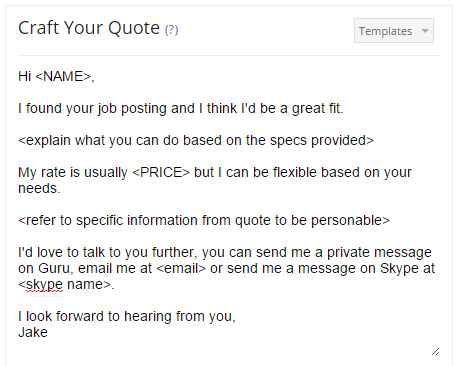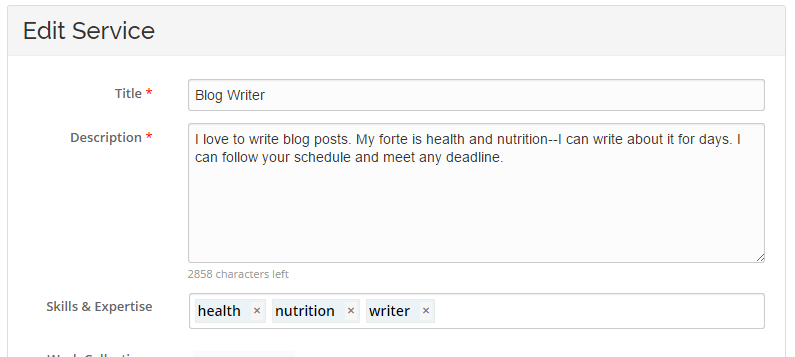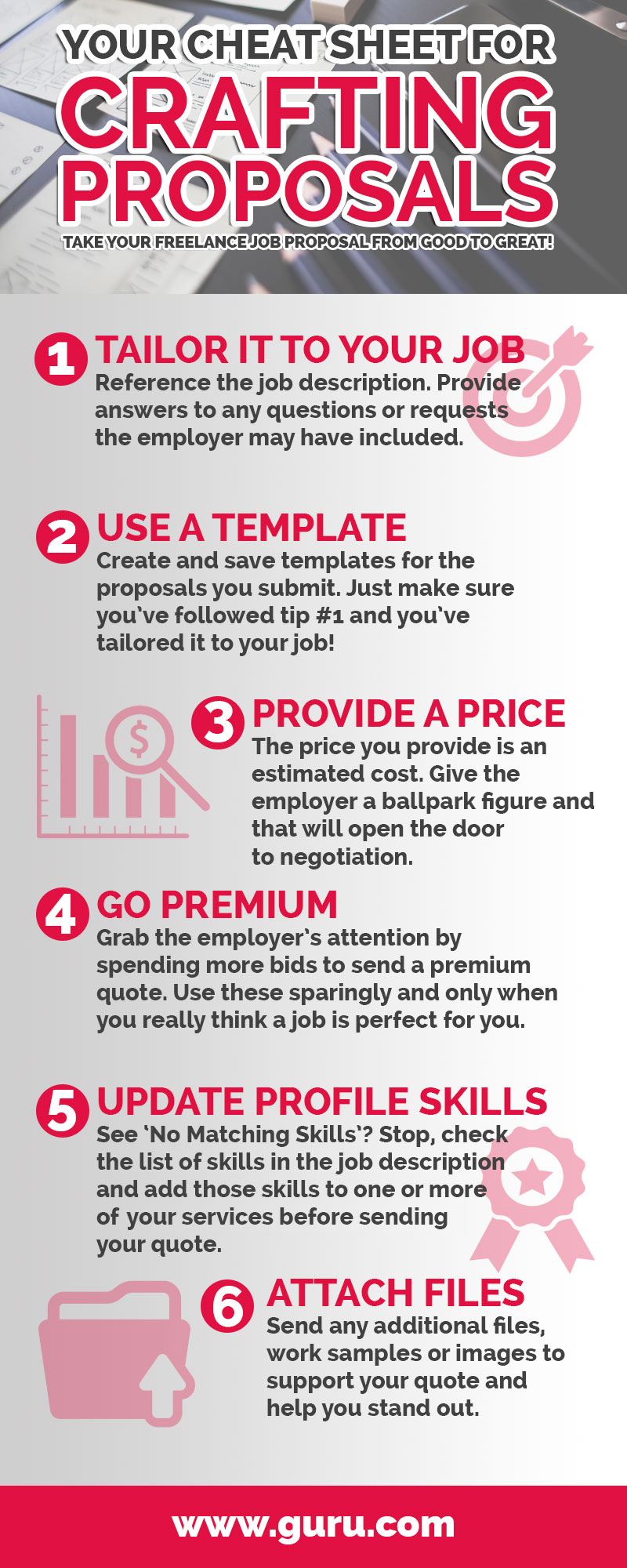Submitting a quote is the easiest way to get hired on Guru. More than likely, an employer is posting a job and has no idea who can get it done. Submitting a quote is your opportunity to sell your services directly to the employer knowing that they’re in the market. The process of submitting a quote is pretty straightforward. However, there are some things you can do to meaningfully increase your odds of being hired.
Below I provide in-depth tips for crafting winning quotes. Looking for the short version? Check out our handy cheat sheet:
6 Hacks for Submitting Quotes That Get You Hired:
1.) Read the employer’s entire job posting
Employers do not want to read your generic, run-of-the-mill proposal. However, it’s kind of hard for an employer to quickly figure out if you’re appealing to them directly or simply dishing out some pre-fabricated response. The most common way they make this determination is to ensure you’ve read their ENTIRE posting. An employer will sometimes throw in something like “please mention the word ‘rabbit’ at the end of your quote so we know you’ve read it”. If you miss this request, there’s a very good chance your quote is being thrown out. Read the whole post and craft your quote to that employer as much as you can!
2.) Use a template but use it to your advantage
We have a template manager on our platform that allows you to quickly insert pre-created content into a quote. You might ask why I would suggest this immediately after telling you to always send a unique quote. However, there is always going to be information in a quote that is generic enough that you can write it out in a template and then tailor it when it comes time to apply to a job. You could do something like this:

The “Templates” drop down at the top right will let you save your template. Give it a shot.
3.) Always try to be specific about your price
I understand it’s tough to nail down a price if you’re truly unsure of the specifics of the job. Especially if the job description is vague. However, we make a point to label the price field as an “estimated cost”. I would say you should error on the side of caution and always try to add an actual number. If anything, your foot is in the door if the employer begins a conversation with you and you can use it as an opportunity to speak in detail and figure the price out. I think, more often than not, it’s better to get a lead that ends in disagreement on price than not getting a lead at all. We will always allow you to choose “placeholder bid” in place of an actual estimation of cost but many employers want to see a hard number, even if it’s a ballpark figure.
4.) Is the job perfect for you? Send a premium quote
If you’re an upgraded member (you need to be Professional level or higher), sending a premium quote to an employer will immediately get their attention. It’s your “hail Mary” play; you don’t want to use it constantly but it’s great when the time calls for it. A premium quote brings you to the top of the list of applicants for a job and tells the employer that you’re serious. I’d use premium quotes sparingly because they’ll quickly exhaust your available bids. If you REALLY think a job is perfect for you, then send them a premium quote. No matter what, make sure what you’ve written to the employer is still excellent. There’s no use in sending a generic quote and spending the bids to make it premium.
5.) Fix “No Matching Skills” any time you see it!
Any time you go to submit a quote, you’ll see a list of skills from your profile that directly match the skills an employer has listed in their job posting. If you have matching skills, we’ll tell you and list them. The more skills you match, the higher your visibility will be and the more we’ll recommend you to an employer. If your skills aren’t matching up but you know you can do the job, check the list of skills the employer included, go back to your list of services within your profile and add one or more of those skills to a service. It’s not cheating to make quick revisions like this—you’re simply optimizing and expanding the breadth of your profile and working intelligently. Here’s my list of skills: 
And here’s where they match up with a job posting:

6.) If you’re not attaching your stuff, you’re doing it wrong
Every single quote you send out should have some kind of attachment. You’ll immediately stand out from the sea of text sent by other freelancers and you’re already convincing an employer to interact with your work. Even if it’s a word document; the employer is opening something you’ve created and reading it. You’re already hooking them! It goes without saying that images are visually stimulating and a great way to catch someone’s attention. If you’re a graphic designer, I can’t think of any reason why you’re not attaching your best work to each quote you send. Our system allows you to directly attach your portfolio pieces (you’ve set up your profile, haven’t you?), attach files directly from your computer and/or attach items from previous quotes. You can use all three sources simultaneously. I admit—none of these are really hacks but I got your attention, didn’t I? You can get the attention of prospective employers if you make your quote compelling enough and use the system to your full advantage. These six tips will give your quote prominence and make it stand out from a lot of your competition. Back your quote up with your skills and communicate well with your employer and you’ll be in great shape to get hired.





31 Comments
Interestingly useful post!
I actually liked your idea for how to do Templates, but my idea also challenges the Employer as much as it does me. Basically, I provide a general template with 4 Section Headers specifically detailing my process, my guarantee of quality/quantity, my time of availability, and my experience that I have under my belt that may be relevant to the said job. Then, I have a template for each specific Job Orientation, such as, Web Research, Creative and Unique Writing, Data Entry, etc. Then, at the very end of my post, I always leave a series of dashes, because Guru does not incorporate the use of the Horizontal Line Rule. After these dashes, I always make sure to include a more personal response.
This more personal response is specifically placed at the end to ensure that my employer has actually read and understood most of the General Guidelines provided above. Even still, surprisingly, I do still receive responses to my quotes from employers who failed to read and understand my “Times of Availability” (I, specifically, mention that I’m on EST time zone, and that I’m not available Tuesday or Sunday).
Everything else mentioned in this posting, I already do, but yet I still only receive roughly 20% or so of my Quotes return responses. And, that’s not including the 30-35 or so Job Matches that I ‘throw-out’ every month. I specifically throw out particular Job Matches who: 1) Failed to provide a proper job description or used less than 2 paragraphs for it. 2) Was either unclear on the price, but wanted it done for less than $250 (whereas my usual wage would be above that) or straight-up posted a desire or comment to pay no more than $100 or $1-7 per hour, etc. 3) Could not use a basic level of English, as communication is the number one key to providing accurate work to my client, and to receiving accurate feedback.
Also, a good 50% of that 20% (a.k.a. 10% overall) of those responses do NOT read or understand all of the General Guidelines that I try my best to point out. I suspect some of this is my fault, but I also suspect that most of it is their fault for not reading or understanding it. Simply put: I’m trying my hardest to be as stupid as possible in my Quotes/Templates, but am failing to do so successfully.
Overall, it’s a very difficult journey, and after everything was all said-and-done, we’re talking, statistically, that I’m only receiving legit responses from 10% out of 10-15 Job Postings per month. And, even then, it’s still not a guarantee to get that job!
Anthonyk747, I like your 4 section header idea, but I wonder if your quotes are too long. You might try putting the personal information first, or work it into your 4 sections. Most people aren’t interested in reading a long, information-dense email, and I suspect that goes for quotes as well. Put that together with the fact that employers who are outsourcing a task are probably already short on time, and you really need to be concise in your quotes.
I’ve been successfully freelancing for 7 years now. (Not all my work is through Guru and I only work when the kids are in school.) I don’t actually send a lot of quotes anymore, but when I do, I make sure to point out how the project matches my skills, and send samples that closely match what the project posting describes. I also focus on a very narrow set of services that I excel at, rather than trying to match up with anything that I *could* do.
However, I do watch items I have submitted quotes for to see if they hire anyone when it’s not me, and I’m finding that there are a number of project postings that never go anywhere. Who’s to say whether they hire outside Guru, decide to do the project themselves (or not at all), or are just fishing to find out how much something would cost? I hope this helps in your quest to get more jobs.
Michele, There is definitely something to be said for concise-yet-thorough quotes. I think it’s more about readability (that’s where Anthony’s headers come into play) than keeping quotes to a certain length. If you include enough of the information (your work terms, available hours, preferred payment methods, etc.) on your profile you shouldn’t need to say more than something like, “Take a look at my profile to see my work terms, available hours, etc.”. The quote can then be more personal in nature and not include so much generic information.
On a side note, we’re looking into making the hiring process even more intuitive, creating more of a flow between an employer’s job posting, your quote, and the agreement once you’ve been hired. Look for that in the near future!
Anthony, the way you use templates seems very efficient! I believe many of our members could learn from this approach.
I think you have two problems with your approach:
1) Your replies are possibly too long and you are boring your potential client. I work as both a guru and a prolific employer on the site. When I get over 20 replies to a project which is very common in the design and writing sections, I do not have time or the energy to read a long reply. I look for: compliance with my needs and differentiators. You need to put some of this stuff in your profile and keep your differentiators and reasons to choose you at the top. If the potential employer is interested they will either contact you or read your profile to get more information.
2) You are perhaps frightening off your potential employer by setting out your “demands” and the employer may think you are going to be a difficult person to work with.
I also think you are wrong to discount people with poor English. This is not a record of intelligence and these guys need your good English and is what they are paying for. Some of my best feedbacks and repeat customers come from people that I have looked after in this way.
Lastly, as an employer I would not welcome being told Guidelines. After all the guru is in a service industry after all.
@Lee and @Michele
I am somewhat inclined towards the “Lazy Reader” approach, as I do often wonder if my templates are too long or too specific, but in the exact same sense where I shouldn’t demand things, in my original posting, I did give an example of how people tend to reply with a Demand first, then a Question second. So, when they Demand that something is to be returned as a sample within 24 hours of a day that I can’t even afford the time to read my emails (on my phone or my computer), and then fail to provide the material that I’m supposed to have done in 24 hours – not only did they not read my Guidelines, but they couldn’t even read their own!
So, I think the real problem here is that I can’t seem to figure out which employer would prefer: The Personal Approach, The Lazy Reader, or The Detailed, Sophisticated Professional. Because, really, what’s what we’re talking about here. Different people have different personalities that affect their work ethic in different ways. My entire templates shout: “Detail Orientated! Professional, Efficient, and Effective! Worth Every Penny!” So, in return, that’s the Client that I’m looking for, and I’m hoping that is what the Client is looking for in a freelancer.
So, honestly, I think Employers/Clients should have a bit more of a Public Profile available. This will allow us to learn about the Client, and learn what type of person they are. This will also, in turn, allow me and others to make more precise bids and target clients with like-attitudes and like-minds.
Excellent idea, Anthony! We are looking into letting employers share more about themselves in a sort of profile in the future.
Sweet! Can’t wait!
Many freelancers have been asking for employer profiles, verification, etc. for a long time, but so far nothing has happened. I would just be happy to see the feedback left for freelancers, like we used to, and vice versa. Can we please have all the feedback returned to employers’ and freelancers’ pages?
Very true. Most look at the price quote. If it’s low, they may contact you.
Great advice!
Any ideas on smashing stand-out opening lines — seen before any attachments — that really draw readers in and make them want to respond asap?
I’ve found simply saying, “Hello, (whatever the name is),
I’d be thrilled to (do whatever the job is, with a mention of something from lower in the post) for you! I have the skills and the experience to complete this job for you exactly the way you want, and not only meet your expectations, but exceed them! And I would be happy to begin work for you for a fee of (and I list the fee)” After that, I go on with the usual blah-blah-blah stuff we all do. I’ve gotten TONS of responses simply because of the way I write when I’m proposing for a job. I try to stay professional, but also use a more conversational tone, which seems to come across as more human and less “template.” Pardon me for saying. I’ve also found some clients like my mentioning my fee so early in the proposal as it lets them know if I made the number or if it was some guess in the dark or whatever. And I explain WHY my fee is what it is, so the client knows I have done my homework and I KNOW my value and I can back up my asking price. It just seems to sound more professional to some of the clients that way.
A *printable* version of this document would be nice. You are preaching to the choir here – giant blood-red fonts are unnecessary and in fact are annoying.
Great advice. I’m glad to see I’ve been right on track.
Very good post! I read it all because I have never won a bid on Guru. I have dropped my rate from $70 USD to $50 USD and hour but how can I compete with $12/hour from someone in Asia?
Actually, I NEVER use a template for a proposal! I find it a base tactic to save time which often can end with some sort of small, easily missed error alerting the potential client to the fact the freelancer is using a template and NOT creating original proposals. And that is a DEFINITE turn-off for just about any client I’ve ever dealt with myself. I do think it a good idea to perhaps create macros for oneself to do just what the template suggestion is meant to do. That also allows the freelancer to reduce the time spent typing information which is the same from each proposal to the next. It prevents errors of omission though which can be so easily missed, as I said before. I was kind of hoping for some new tips. I already do what’s suggested in the cheat sheet! I’m waiting expectantly for the next one!
I have employed many of the same techniques over the time I have used Guru. I have won one bid, but have had a few bites on other project quotes. I have a base rate of $25.00 an hour and flexible with my pricing. Like Dave I find it frustrating to compete with artists who can bid a job for $12.00 hour. I still read my e-mails from Guru, but rarely bid on a project unless I have most or all qualifications employer is looking for…great service, but not a reliable source of revenue for me.
Same for me…
I am wondering that I can give my personal email and skype name. Few Clints requested, but I scared to do that thinking of account may block. Maybe I am wrong!
Siva, feel free to communicate with your clients however you like, including through Skype! In fact, with the new dashboard you can now easily add your Skype account under “Your Profile”. The more transparent you are with clients, the better.
Thanks, helpful for newbies.
Good IDEAS!
I love the ways you guys are treating this issue of employer-client relationship. It’s quite stimulating! However, I’ll like every freelancer here to be objective in responding to issues on this platform.
I wish to also add that what worked for Mr A may not work for Mr B. So the use of template should be creatively and objectively adopted. I want to agree with Anthony and others that the information about any prospective employer should be known in other to know what to add or not to add to one’s quote. Above all, as a freelancer you need to be frank when applying for a job. For instance, I was employed for a job which I later discovered during the process of discussion through emails that the amount budgeted by the employer is less than task involved in the job. So I told him that I won’t be able to continue with the job for the reason I’ve mentioned above, and he was so delighted to hear that. Let’s try to build our job by being sincere.
I wanted to say KUDOS Yay!!! to the attachment window allowing selection from previous bids in a tab. Really a plus Thank You.
I love being able to use templates on Guru, it saves me a lot of time and helps me to not forget items in the job process. I just make up a proposal letter for each kind of project that I want to bid on.
The new attachment window is a great improvement!
Hi all,
I’m new here and I need some help. I’m afraid of making mistakes that might cost me some money. I’m in Argentina and I can not afford to waste any money. I work at a bilingual school but my salary is not enough and I’ve been doing voluntary work for Coursera, translating and mentoring, so I decided I would try freelancing. My question is: do we have to pay anything if we are hired? How do I apply? I saw that some quotes had the name of the person and a yearly amount of money, what is that? I didn’t see any information there. How do you show how much you want to earn? Is it in the bid? Is that per hour?
Thanks!
Hi Laura, Welcome! To answer your questions:
1) You don’t pay anything for getting hired, but you pay a 4.95% – 8.95% transaction fee when you get paid. This fee is based on your membership level and is deducted from your payment for the job. Membership is free but you can purchase membership to gain access to more benefits.
2) You can apply for jobs for free, just submit a quote! You can find jobs either by searching or responding to your leads. Before you apply, make sure your profile is completely filled out and you’ve added to your portfolio and services! That’s the best way to get hired.
3) When you create your services, you designate how much you want to earn per-hour, and how much minimum you want to earn per-job. Then in your quote, you provide an estimated cost to give the employer an idea. When you get hired, you will create an agreement with your employer in which you can detail out how you want to be paid, and when. You can select either hourly or by the milestone.
Dear Anna,
I just posted a job but I Quoted the fee in a range. How can I go back to the job to change the wording? Thank you.
Rosemary
Hi, Rosemary! Click on the job title under Quotes on your dashboard, and then click the “Posting” tab. You will then see your original job posting, with an “Edit” button in the top right corner of the page. Click that and you can make edits.
hi i am new here and i am a game revewier i got stuck in applying a job in the section adding quotes is there a maximum amount of money one can earn from guru?
Hi Kevin, There is no maximum amount you can earn on Guru – the sky’s the limit! Apply for as many jobs as you want and work for as many employers as you want. You can learn more about getting paid on Guru in our Help Center: https://www.guru.com/help/freelancer/withdrawals-and-payments/
Hi Anna
Many thanks for the guidance. However, even after going through the above points and making an honest attempt to imbibe it religiously, I am yet to get lucky to get my first job. What should I do..at times I don’t even have money to buy bids once I am exhausted with Free ones..
Regards
K
Hey Team
Everyone is here to get projects out of bidding. In order to grow from a Novice profile to a Pro profile ,I wish we had some Country wise, local freelancers to educate or assist us .
Thanks
Mansoor@eamanitech.com